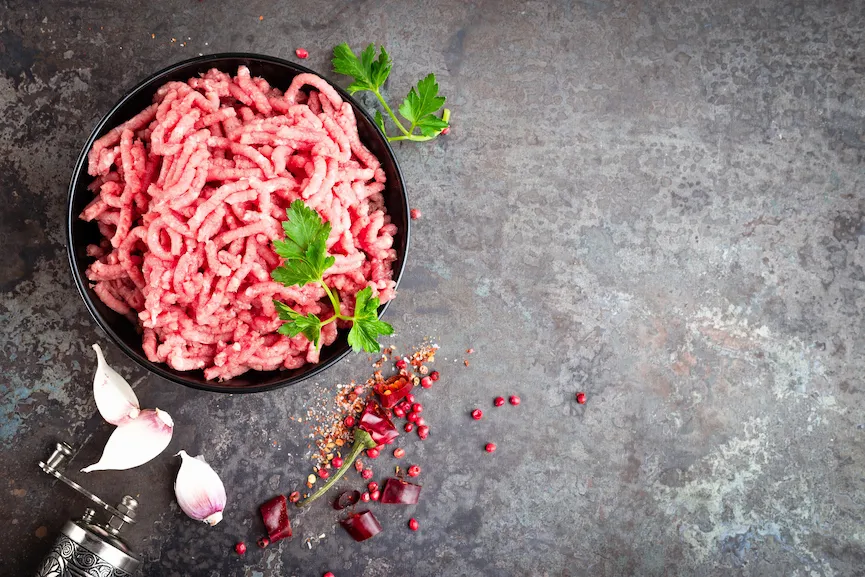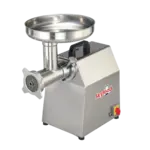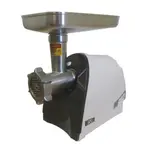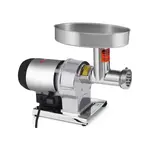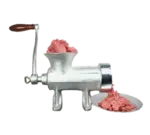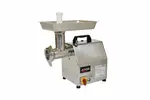
Tips for Properly Grinding Meat in a Food Processor
When it comes to creating delectable dishes, the freshness and quality of your ingredients play a pivotal role. For those who take their culinary skills seriously, grinding meat at home can elevate your recipes to a whole new level. If you're wondering how to achieve this without investing in a separate meat grinder, we have the perfect solution for you - a food processor! In this guide, we'll walk you through the step-by-step process of grinding meat using a food processor. Whether you're a seasoned chef, a home cook, or simply an enthusiast looking to enhance your cooking game, this article is tailored just for you.
How to Grind Meat in a Food Processor
Image source: Depositphotos
Grinding meat with a commercial food processor may seem like a daunting task, but with the right procedure, it can be a straightforward and rewarding process. Let's dive into the details:
Choose the Right Type of Meat
The foundation of any great ground meat creation is, of course, the meat itself. Opt for cuts that contain a balanced ratio of fat to lean meat. This ensures both flavor and juiciness in your final dishes. Some excellent options include beef chuck, pork shoulder, chicken thighs, lamb shoulder, and turkey thigh meat. Remember, the quality of the meat greatly influences the taste and texture of the end product.
Select the Right Food Processor
Not all food processors are created equal, and not all are suitable for grinding meat. Look for a commercial food processor model that comes equipped with a meat grinder attachment. This attachment is designed to handle the tough task of grinding meat and ensures optimal results. For commercial-grade options, make sure to explore our range of commercial food processors.
Prepare the Meat for Grinding
Before you begin, it's essential to properly prepare the meat. Trim away any excess fat, sinew, or gristle from the meat. Cut the meat into smaller chunks, roughly 1 inch in size. Chilling the meat in the freezer for about 20-30 minutes before grinding can make the process smoother by preventing the meat from becoming overly soft.
Mix and Flavor the Ground Meat
For an added layer of deliciousness, consider mixing different types of meats or adding seasonings to your ground meat. You can create custom blends that suit your specific recipe needs, from flavorful burgers to savory meatballs.
Store the Meat Properly After Grinding
Once you've ground your meat, it's important to handle it with care. Store the ground meat in an airtight container in the refrigerator and use it within a day or two to maintain freshness and quality.
Prepare Your Processor for Future Use
Proper maintenance ensures that when you grind meat in a food processor, it continues to deliver outstanding results. Clean the grinding attachment and food processor components thoroughly according to the manufacturer's instructions.
Types of Meat Suitable for Grinding

Different types of meat offer unique flavors and textures when ground. Here are some popular choices:
Beef
Beef chuck and sirloin are great choices for rich and hearty ground meat. These cuts provide a perfect balance of fat and lean meat, resulting in flavorful and juicy ground beef.
Pork
A pork shoulder or butt is commonly used for ground pork, providing a well-balanced fat-to-lean ratio. This combination ensures that your ground pork is both succulent and flavorful, making it ideal for a wide range of recipes.
Chicken
Chicken thighs yield a tender and flavorful ground chicken perfect for various dishes. The slightly higher fat content in chicken thighs adds richness and moisture to your ground chicken, enhancing its taste and texture.
Lamb
Lamb shoulder is prized for its distinct flavor and is an excellent choice for Mediterranean-inspired dishes. When ground, lamb shoulder offers a robust and earthy taste that pairs well with aromatic herbs and spices.
Turkey
Turkey thigh meat is a lean option that can be used as a healthier alternative in recipes. Ground turkey thighs retain moisture and tenderness, making them a versatile choice for creating lean and delicious ground meat dishes.
What Are the Safety Precautions for Food Processors?

When it comes to grinding meat in a food processor, safety should always be a top priority. Proper practices and precautions are crucial to ensuring that your culinary endeavors remain not only delicious but also safe for consumption. Let's delve deeper into the key safety measures to keep in mind:
Handling Raw Meat Properly to Prevent Contamination
Raw meat is a potential breeding ground for harmful bacteria, such as Salmonella and E. coli. To minimize the risk of contamination, it's essential to practice thorough hygiene. Before and after handling raw meat, wash your hands vigorously with soap and warm water for at least 20 seconds. This simple step helps reduce the chances of transferring bacteria to other surfaces or ingredients. Additionally, ensure that all utensils, cutting boards, and countertops that come into contact with raw meat are promptly cleaned and sanitized.
Avoiding Overfilling the Food Processor
The food processor's grinding attachment is a powerful tool, but like any machinery, it has its limits. Overfilling the attachment with too much meat can strain the motor, potentially leading to inefficient grinding or even causing the appliance to malfunction. To achieve optimal results, it's advisable to divide your meat into manageable portions and process them in batches. This not only ensures consistent grinding but also prevents unnecessary stress on the food processor's components.
Preventing Overheating of the Food Processor
While grinding meat, the food processor's motor can generate heat. Continuous operation without breaks may lead to overheating, affecting the motor's performance and potentially shortening its lifespan. To prevent this, practice periodic pauses during the grinding process. This gives the motor a chance to cool down and helps maintain its efficiency over time. If you notice that the food processor becomes excessively warm to the touch when you grind meat, you should switch it off and allow it to cool before resuming the grinding process.
Tips for Cleaning the Food Processor After Grinding Meat

Maintaining hygiene and longevity is of utmost importance, especially after you grind meat in the food processor as it can leave behind residues and particles. Proper and thorough cleaning not only ensures the safety of your food but also helps your appliance function optimally over time. Here's a detailed guide on how to effectively clean your food processor after grinding meat:
Disassemble the Food Processor
After you've finished grinding meat in the food processor, start the cleaning process by carefully disassembling all components, including the grinding attachment. This step allows you to access every nook and cranny where meat particles might be trapped.
Scrape Off Excess Meat
Use a spatula or a similar tool to gently and meticulously scrape off any visible meat residue from the grinding attachment and other parts of the food processor. Ensuring that you remove as much residue as possible at this stage makes the subsequent cleaning steps more effective.
Soak in Warm Soapy Water
To loosen and dissolve any remaining meat particles, fill a basin or sink with warm water and add mild dish soap. Submerge the disassembled components in this soapy solution and allow them to soak. This step helps break down fats and proteins, making it easier to remove stubborn residues.
Scrub with a Brush
After soaking, use a soft-bristled brush to gently scrub all the components. Pay close attention to areas that might still have grime clinging to them. The brush's bristles help dislodge particles that have loosened during soaking, ensuring a thorough clean.
Rinse Thoroughly
Rinse all the components under cool running water to remove soap, debris, and any remaining meat particles. Thorough rinsing ensures that no cleaning solution residue is left behind, which could potentially affect the taste and safety of future dishes.
Sanitize with Boiling Water
For an added layer of hygiene, consider briefly dipping the components in boiling water. Boiling water acts as a natural sanitizer, helping to eliminate any lingering bacteria or germs that might be present on the surfaces. Be cautious when handling hot components.
Let It Dry
Allow all components to air-dry completely before reassembling the food processor. Dampness can lead to mold growth or other issues, so ensure that each piece is thoroughly dry. Once everything is dry, carefully reassemble the food processor for its next use.
By following these detailed cleaning steps, you're not only ensuring the cleanliness of your food processor but also contributing to its longevity and the safety of your culinary creations. Proper cleaning after each use, especially after grinding meat, maintains the integrity of your appliance and preserves the flavors of your dishes. A clean food processor is a reliable tool that empowers you to continue experimenting and delighting in your kitchen endeavors.
To Wrap Up!

Mastering the art of grinding meat in a food processor opens up a world of culinary possibilities, allowing you to create mouthwatering dishes with unparalleled freshness and flavor. The comprehensive roadmap in this guide, from selecting the right meat and food processor to handling raw meat safely and maintaining your equipment's hygiene can help you confidently embark on your meat grinding journey, whether you're a seasoned chef or an aspiring home cook.
Remember, the key lies not only in the process itself but also in the care you take before, during, and after each grinding session. With your newfound knowledge and expertise, your kitchen creations are bound to reach new heights of deliciousness, impressing all those who savor your delectable creations. So, fire up your food processor, embrace the joys of grinding meat at home, and savor the culinary delights that await you. Happy cooking!
FAQ
Can a Food Processor Grind Meat?
Yes, you can grind meat in a food processor. While it may not be as specialized as a dedicated meat grinder, a food processor can effectively grind various types of meat, especially when equipped with a meat grinding attachment or blade. It's essential to choose cuts of meat with an appropriate fat-to-lean ratio for optimal results and to follow proper techniques to ensure that the food processor's motor is not strained and the meat is ground to the desired consistency.
Which Cuts of Meats Should I Grind?
Opt for cuts with a balanced fat-to-lean ratio, such as beef chuck, pork shoulder, chicken thighs, lamb shoulder, and turkey thigh meat. These cuts offer a harmonious blend of flavors and textures, resulting in delicious and versatile ground meat perfect for various culinary creations.
Can a Food Processor Grind Bones?
Most food processors are not designed to handle bones. It's recommended to stick to grinding boneless meat to avoid damaging your appliance. Attempting to grind bones in a food processor can cause strain on the motor, potentially leading to malfunctions or breakage.
Can a Food Processor Replace a Meat Grinder?
While a food processor can be used to grind meat, it's important to note that a dedicated meat grinder typically delivers superior results for achieving a finer, more consistent texture. Meat grinders are specifically designed to handle the demands of grinding meat and can produce optimal outcomes for various recipes.
What Is the Difference Between a Meat Grinder and a Food Processor?
The main distinction between a meat grinder and a food processor lies in their primary functions. A meat grinder is purpose-built for grinding meat, ensuring a consistent texture and preserving the integrity of the meat's fibers. On the other hand, a food processor is a versatile kitchen appliance that can handle a wide range of tasks, including grinding, but may not provide the same level of precision and consistency as a dedicated meat grinder.
What Should You Not Put in a Food Processor?
It's important to exercise caution when using a food processor. Avoid processing extremely hard items, liquids that exceed the maximum fill line, and items that could potentially damage the blades. Specifically, bones and certain tough spices should not be processed in a food processor, as they can cause blade damage and compromise the appliance's performance.
